Critical Review: Early Mobilisation in ICU Patients and Outcomes
VerifiedAdded on 2022/08/16
|8
|1532
|11
Report
AI Summary
This report presents a critical review protocol examining the effects of early mobilisation on post-operative adult patients within intensive care units (ICUs). The introduction highlights the current practice of complete bed rest and sedation in ICUs, identifying the associated risks such as ICU-acquired weakness and its impact on patient quality of life. The rationale emphasizes the importance of early mobilisation in mitigating these risks and facilitating rapid functional recovery. The report formulates a precise review question using the PICO(T) framework to guide the investigation, focusing on the comparison between early mobilisation and complete bed rest over a 12-month period. It outlines the search methodology, including databases like Google Scholar, PubMed, and MEDLINE, along with relevant keywords and inclusion/exclusion criteria. The report also details the literature justification and appraisal process, prioritizing systematic reviews and randomized controlled trials. A literature review plan is established to assemble evidence, critically appraise articles, and summarize study outcomes, with the National Health and Medical Research Council (NHMRC) guidelines providing evidence ranking. The conclusion summarizes the importance of early mobilisation in improving patient outcomes, emphasizing the need for further research to refine inclusion/exclusion principles and identify optimal mobilisation models.
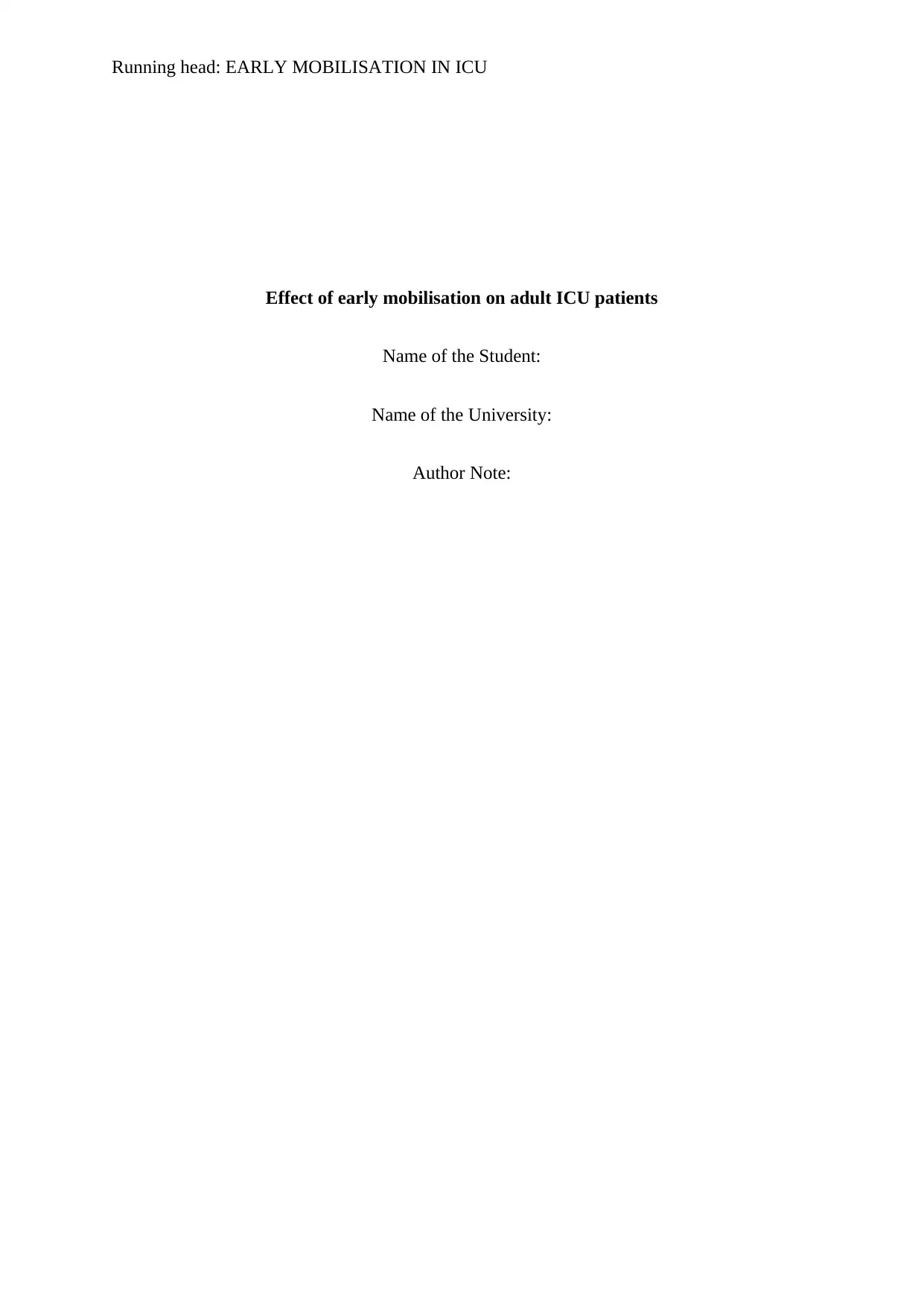
Running head: EARLY MOBILISATION IN ICU
Effect of early mobilisation on adult ICU patients
Name of the Student:
Name of the University:
Author Note:
Effect of early mobilisation on adult ICU patients
Name of the Student:
Name of the University:
Author Note:
Paraphrase This Document
Need a fresh take? Get an instant paraphrase of this document with our AI Paraphraser
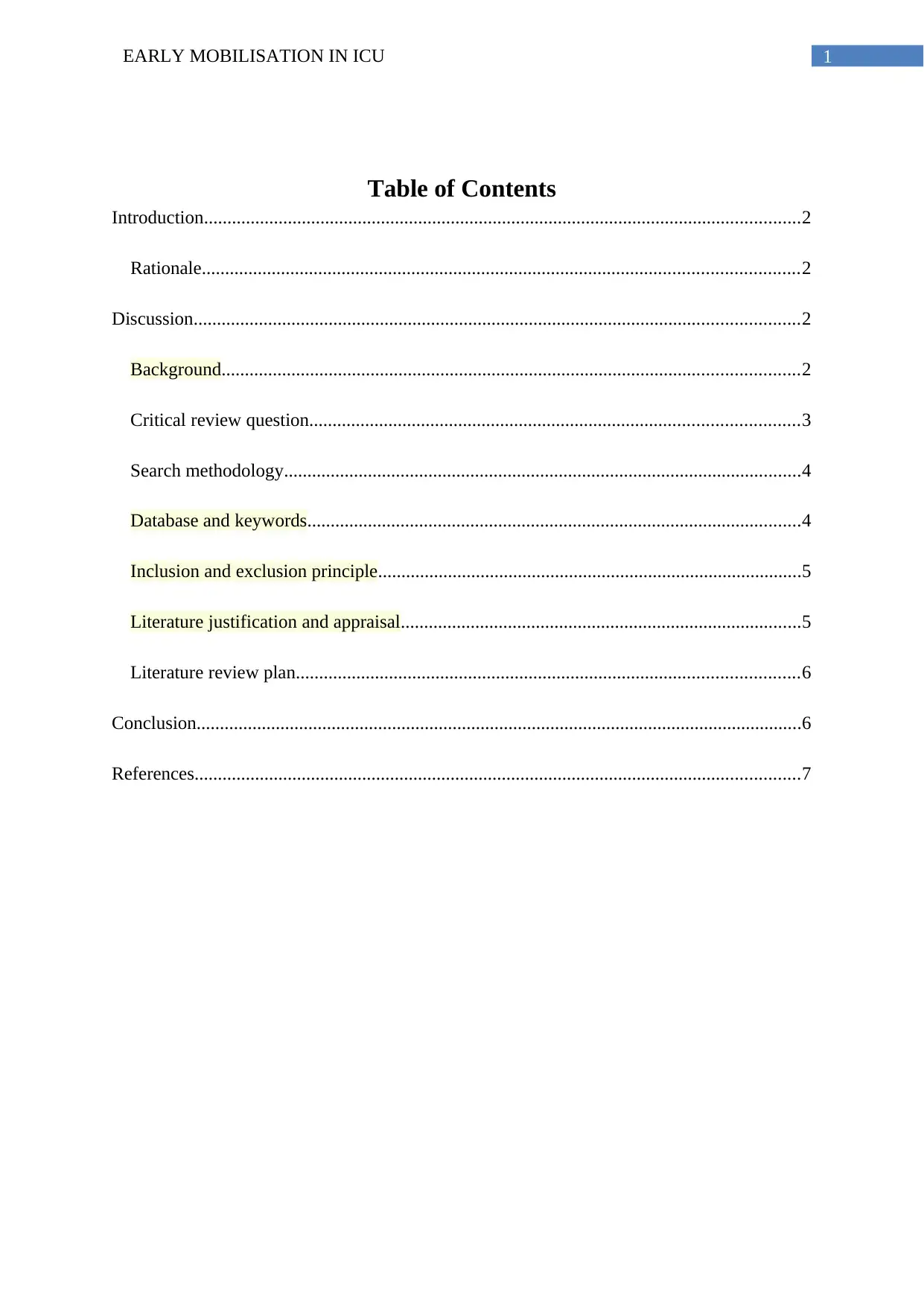
1EARLY MOBILISATION IN ICU
Table of Contents
Introduction................................................................................................................................2
Rationale................................................................................................................................2
Discussion..................................................................................................................................2
Background............................................................................................................................2
Critical review question.........................................................................................................3
Search methodology...............................................................................................................4
Database and keywords..........................................................................................................4
Inclusion and exclusion principle...........................................................................................5
Literature justification and appraisal......................................................................................5
Literature review plan............................................................................................................6
Conclusion..................................................................................................................................6
References..................................................................................................................................7
Table of Contents
Introduction................................................................................................................................2
Rationale................................................................................................................................2
Discussion..................................................................................................................................2
Background............................................................................................................................2
Critical review question.........................................................................................................3
Search methodology...............................................................................................................4
Database and keywords..........................................................................................................4
Inclusion and exclusion principle...........................................................................................5
Literature justification and appraisal......................................................................................5
Literature review plan............................................................................................................6
Conclusion..................................................................................................................................6
References..................................................................................................................................7
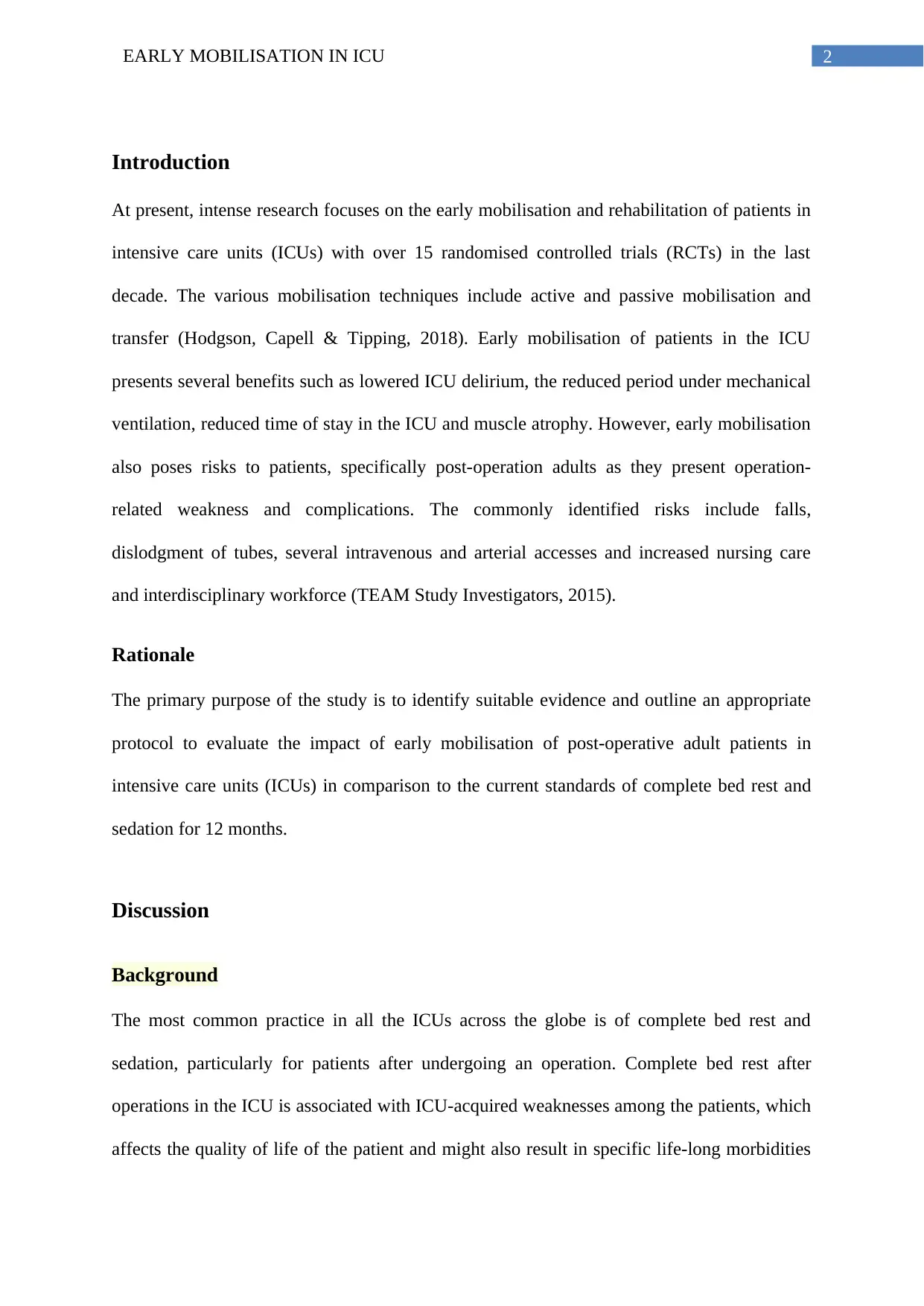
2EARLY MOBILISATION IN ICU
Introduction
At present, intense research focuses on the early mobilisation and rehabilitation of patients in
intensive care units (ICUs) with over 15 randomised controlled trials (RCTs) in the last
decade. The various mobilisation techniques include active and passive mobilisation and
transfer (Hodgson, Capell & Tipping, 2018). Early mobilisation of patients in the ICU
presents several benefits such as lowered ICU delirium, the reduced period under mechanical
ventilation, reduced time of stay in the ICU and muscle atrophy. However, early mobilisation
also poses risks to patients, specifically post-operation adults as they present operation-
related weakness and complications. The commonly identified risks include falls,
dislodgment of tubes, several intravenous and arterial accesses and increased nursing care
and interdisciplinary workforce (TEAM Study Investigators, 2015).
Rationale
The primary purpose of the study is to identify suitable evidence and outline an appropriate
protocol to evaluate the impact of early mobilisation of post-operative adult patients in
intensive care units (ICUs) in comparison to the current standards of complete bed rest and
sedation for 12 months.
Discussion
Background
The most common practice in all the ICUs across the globe is of complete bed rest and
sedation, particularly for patients after undergoing an operation. Complete bed rest after
operations in the ICU is associated with ICU-acquired weaknesses among the patients, which
affects the quality of life of the patient and might also result in specific life-long morbidities
Introduction
At present, intense research focuses on the early mobilisation and rehabilitation of patients in
intensive care units (ICUs) with over 15 randomised controlled trials (RCTs) in the last
decade. The various mobilisation techniques include active and passive mobilisation and
transfer (Hodgson, Capell & Tipping, 2018). Early mobilisation of patients in the ICU
presents several benefits such as lowered ICU delirium, the reduced period under mechanical
ventilation, reduced time of stay in the ICU and muscle atrophy. However, early mobilisation
also poses risks to patients, specifically post-operation adults as they present operation-
related weakness and complications. The commonly identified risks include falls,
dislodgment of tubes, several intravenous and arterial accesses and increased nursing care
and interdisciplinary workforce (TEAM Study Investigators, 2015).
Rationale
The primary purpose of the study is to identify suitable evidence and outline an appropriate
protocol to evaluate the impact of early mobilisation of post-operative adult patients in
intensive care units (ICUs) in comparison to the current standards of complete bed rest and
sedation for 12 months.
Discussion
Background
The most common practice in all the ICUs across the globe is of complete bed rest and
sedation, particularly for patients after undergoing an operation. Complete bed rest after
operations in the ICU is associated with ICU-acquired weaknesses among the patients, which
affects the quality of life of the patient and might also result in specific life-long morbidities
⊘ This is a preview!⊘
Do you want full access?
Subscribe today to unlock all pages.

Trusted by 1+ million students worldwide
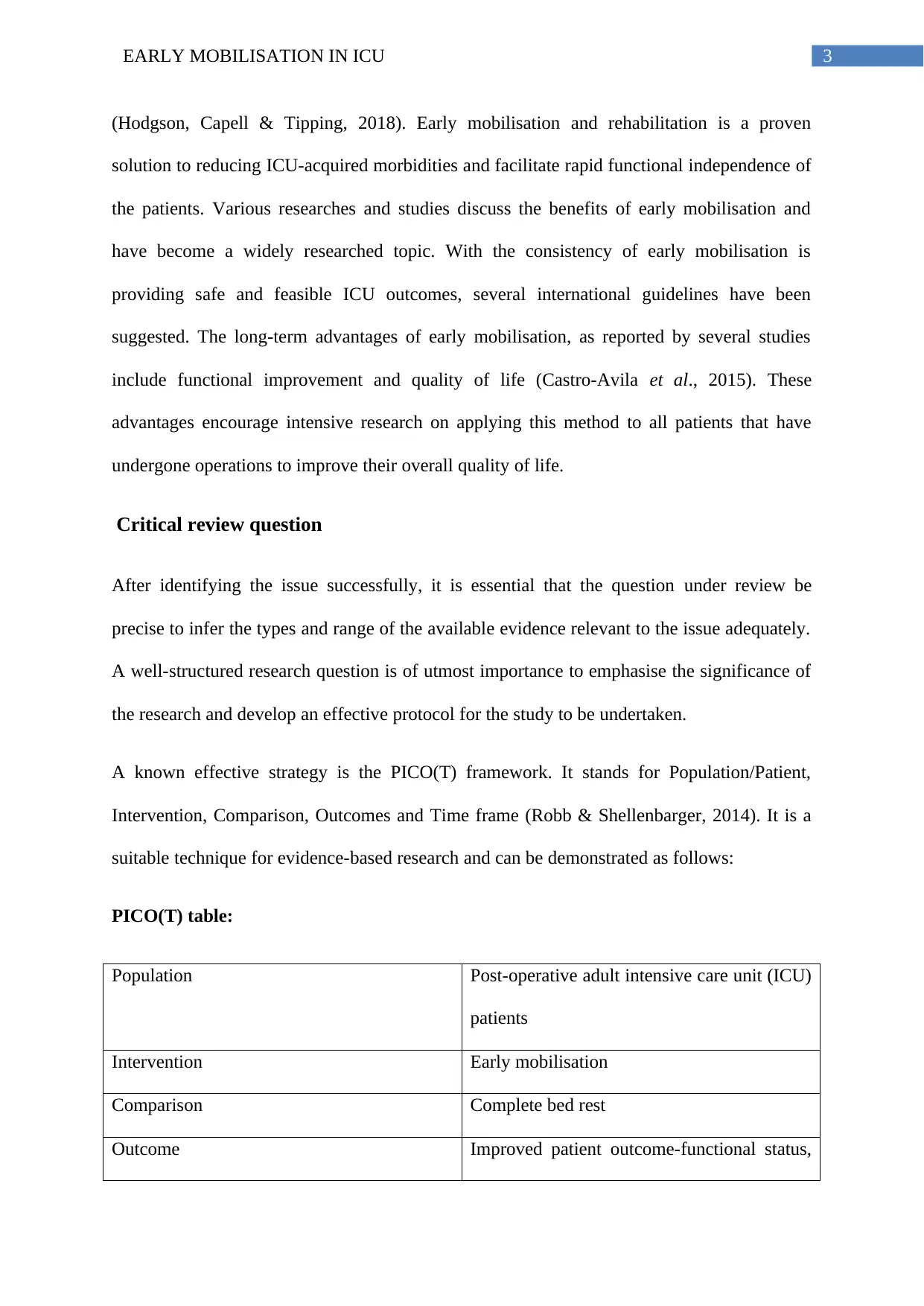
3EARLY MOBILISATION IN ICU
(Hodgson, Capell & Tipping, 2018). Early mobilisation and rehabilitation is a proven
solution to reducing ICU-acquired morbidities and facilitate rapid functional independence of
the patients. Various researches and studies discuss the benefits of early mobilisation and
have become a widely researched topic. With the consistency of early mobilisation is
providing safe and feasible ICU outcomes, several international guidelines have been
suggested. The long-term advantages of early mobilisation, as reported by several studies
include functional improvement and quality of life (Castro-Avila et al., 2015). These
advantages encourage intensive research on applying this method to all patients that have
undergone operations to improve their overall quality of life.
Critical review question
After identifying the issue successfully, it is essential that the question under review be
precise to infer the types and range of the available evidence relevant to the issue adequately.
A well-structured research question is of utmost importance to emphasise the significance of
the research and develop an effective protocol for the study to be undertaken.
A known effective strategy is the PICO(T) framework. It stands for Population/Patient,
Intervention, Comparison, Outcomes and Time frame (Robb & Shellenbarger, 2014). It is a
suitable technique for evidence-based research and can be demonstrated as follows:
PICO(T) table:
Population Post-operative adult intensive care unit (ICU)
patients
Intervention Early mobilisation
Comparison Complete bed rest
Outcome Improved patient outcome-functional status,
(Hodgson, Capell & Tipping, 2018). Early mobilisation and rehabilitation is a proven
solution to reducing ICU-acquired morbidities and facilitate rapid functional independence of
the patients. Various researches and studies discuss the benefits of early mobilisation and
have become a widely researched topic. With the consistency of early mobilisation is
providing safe and feasible ICU outcomes, several international guidelines have been
suggested. The long-term advantages of early mobilisation, as reported by several studies
include functional improvement and quality of life (Castro-Avila et al., 2015). These
advantages encourage intensive research on applying this method to all patients that have
undergone operations to improve their overall quality of life.
Critical review question
After identifying the issue successfully, it is essential that the question under review be
precise to infer the types and range of the available evidence relevant to the issue adequately.
A well-structured research question is of utmost importance to emphasise the significance of
the research and develop an effective protocol for the study to be undertaken.
A known effective strategy is the PICO(T) framework. It stands for Population/Patient,
Intervention, Comparison, Outcomes and Time frame (Robb & Shellenbarger, 2014). It is a
suitable technique for evidence-based research and can be demonstrated as follows:
PICO(T) table:
Population Post-operative adult intensive care unit (ICU)
patients
Intervention Early mobilisation
Comparison Complete bed rest
Outcome Improved patient outcome-functional status,
Paraphrase This Document
Need a fresh take? Get an instant paraphrase of this document with our AI Paraphraser
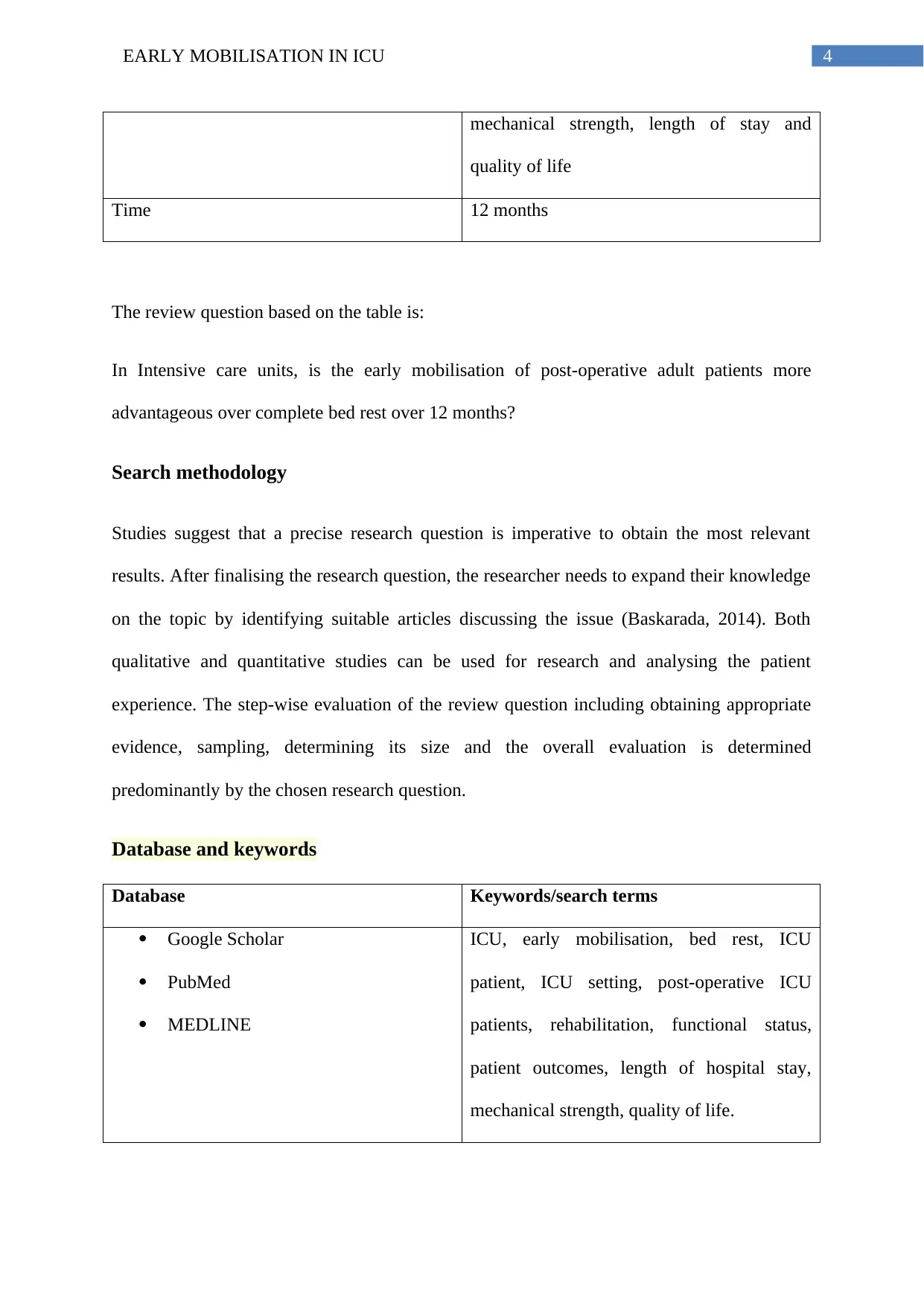
4EARLY MOBILISATION IN ICU
mechanical strength, length of stay and
quality of life
Time 12 months
The review question based on the table is:
In Intensive care units, is the early mobilisation of post-operative adult patients more
advantageous over complete bed rest over 12 months?
Search methodology
Studies suggest that a precise research question is imperative to obtain the most relevant
results. After finalising the research question, the researcher needs to expand their knowledge
on the topic by identifying suitable articles discussing the issue (Baskarada, 2014). Both
qualitative and quantitative studies can be used for research and analysing the patient
experience. The step-wise evaluation of the review question including obtaining appropriate
evidence, sampling, determining its size and the overall evaluation is determined
predominantly by the chosen research question.
Database and keywords
Database Keywords/search terms
Google Scholar
PubMed
MEDLINE
ICU, early mobilisation, bed rest, ICU
patient, ICU setting, post-operative ICU
patients, rehabilitation, functional status,
patient outcomes, length of hospital stay,
mechanical strength, quality of life.
mechanical strength, length of stay and
quality of life
Time 12 months
The review question based on the table is:
In Intensive care units, is the early mobilisation of post-operative adult patients more
advantageous over complete bed rest over 12 months?
Search methodology
Studies suggest that a precise research question is imperative to obtain the most relevant
results. After finalising the research question, the researcher needs to expand their knowledge
on the topic by identifying suitable articles discussing the issue (Baskarada, 2014). Both
qualitative and quantitative studies can be used for research and analysing the patient
experience. The step-wise evaluation of the review question including obtaining appropriate
evidence, sampling, determining its size and the overall evaluation is determined
predominantly by the chosen research question.
Database and keywords
Database Keywords/search terms
Google Scholar
PubMed
MEDLINE
ICU, early mobilisation, bed rest, ICU
patient, ICU setting, post-operative ICU
patients, rehabilitation, functional status,
patient outcomes, length of hospital stay,
mechanical strength, quality of life.
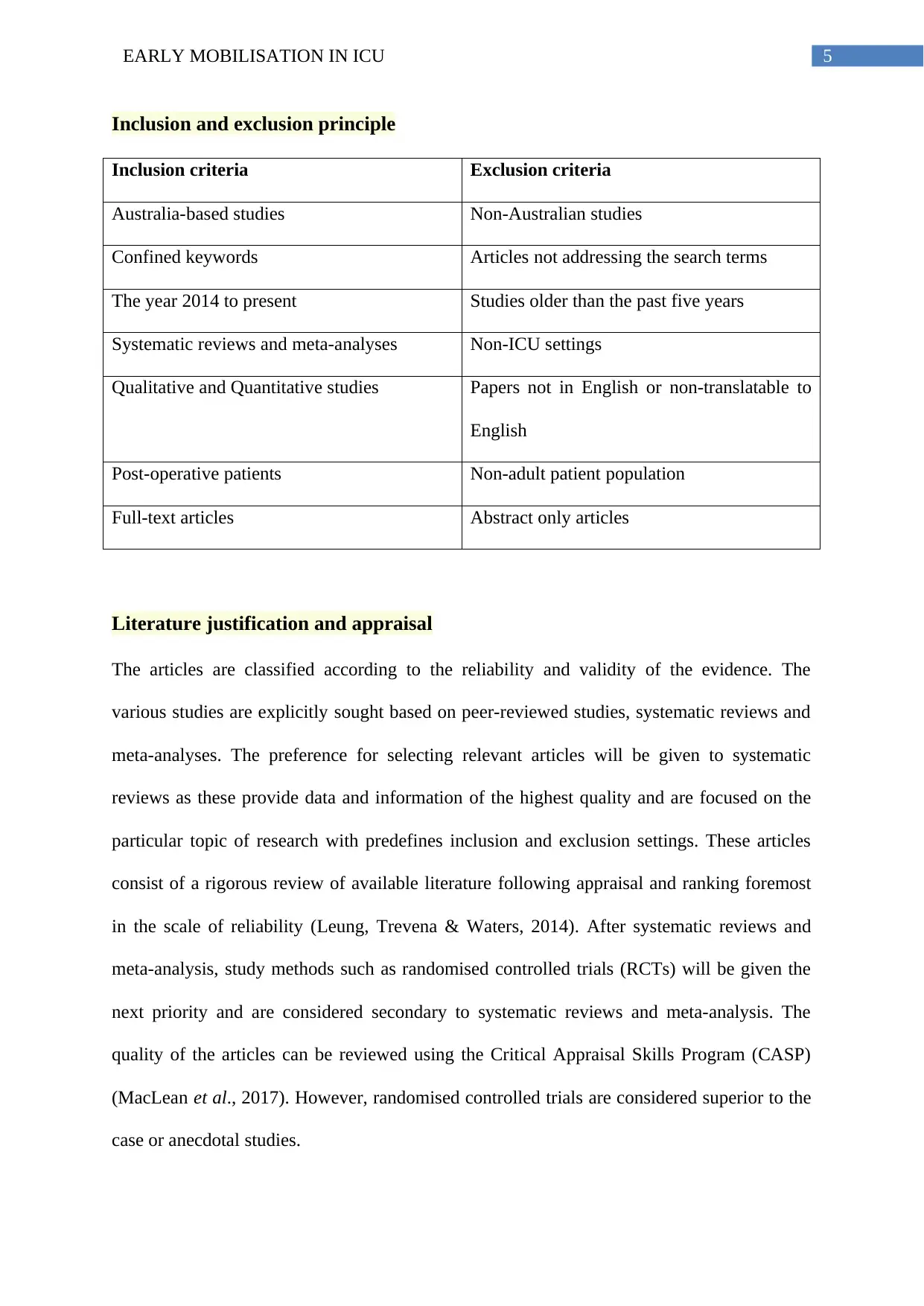
5EARLY MOBILISATION IN ICU
Inclusion and exclusion principle
Inclusion criteria Exclusion criteria
Australia-based studies Non-Australian studies
Confined keywords Articles not addressing the search terms
The year 2014 to present Studies older than the past five years
Systematic reviews and meta-analyses Non-ICU settings
Qualitative and Quantitative studies Papers not in English or non-translatable to
English
Post-operative patients Non-adult patient population
Full-text articles Abstract only articles
Literature justification and appraisal
The articles are classified according to the reliability and validity of the evidence. The
various studies are explicitly sought based on peer-reviewed studies, systematic reviews and
meta-analyses. The preference for selecting relevant articles will be given to systematic
reviews as these provide data and information of the highest quality and are focused on the
particular topic of research with predefines inclusion and exclusion settings. These articles
consist of a rigorous review of available literature following appraisal and ranking foremost
in the scale of reliability (Leung, Trevena & Waters, 2014). After systematic reviews and
meta-analysis, study methods such as randomised controlled trials (RCTs) will be given the
next priority and are considered secondary to systematic reviews and meta-analysis. The
quality of the articles can be reviewed using the Critical Appraisal Skills Program (CASP)
(MacLean et al., 2017). However, randomised controlled trials are considered superior to the
case or anecdotal studies.
Inclusion and exclusion principle
Inclusion criteria Exclusion criteria
Australia-based studies Non-Australian studies
Confined keywords Articles not addressing the search terms
The year 2014 to present Studies older than the past five years
Systematic reviews and meta-analyses Non-ICU settings
Qualitative and Quantitative studies Papers not in English or non-translatable to
English
Post-operative patients Non-adult patient population
Full-text articles Abstract only articles
Literature justification and appraisal
The articles are classified according to the reliability and validity of the evidence. The
various studies are explicitly sought based on peer-reviewed studies, systematic reviews and
meta-analyses. The preference for selecting relevant articles will be given to systematic
reviews as these provide data and information of the highest quality and are focused on the
particular topic of research with predefines inclusion and exclusion settings. These articles
consist of a rigorous review of available literature following appraisal and ranking foremost
in the scale of reliability (Leung, Trevena & Waters, 2014). After systematic reviews and
meta-analysis, study methods such as randomised controlled trials (RCTs) will be given the
next priority and are considered secondary to systematic reviews and meta-analysis. The
quality of the articles can be reviewed using the Critical Appraisal Skills Program (CASP)
(MacLean et al., 2017). However, randomised controlled trials are considered superior to the
case or anecdotal studies.
⊘ This is a preview!⊘
Do you want full access?
Subscribe today to unlock all pages.

Trusted by 1+ million students worldwide
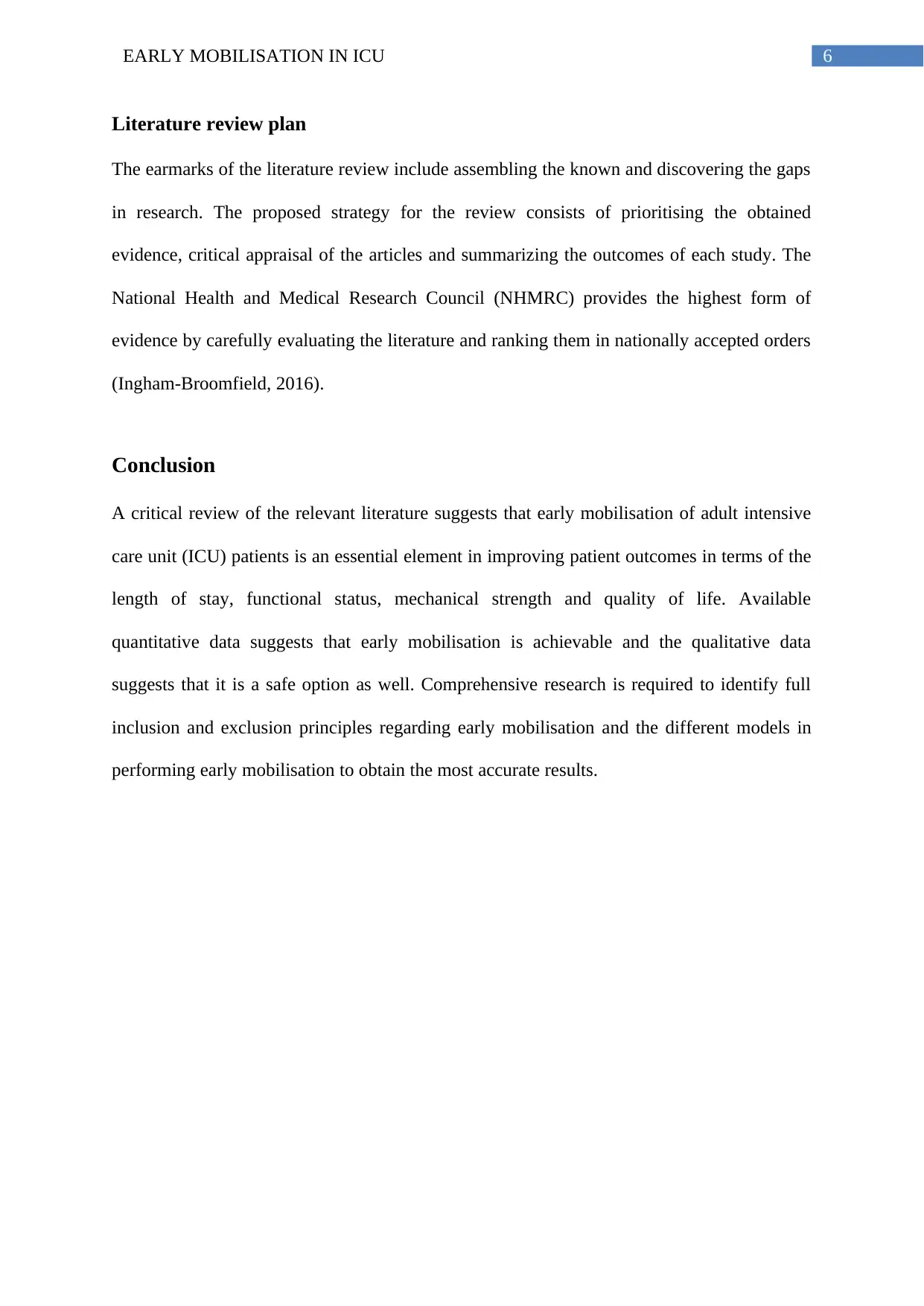
6EARLY MOBILISATION IN ICU
Literature review plan
The earmarks of the literature review include assembling the known and discovering the gaps
in research. The proposed strategy for the review consists of prioritising the obtained
evidence, critical appraisal of the articles and summarizing the outcomes of each study. The
National Health and Medical Research Council (NHMRC) provides the highest form of
evidence by carefully evaluating the literature and ranking them in nationally accepted orders
(Ingham-Broomfield, 2016).
Conclusion
A critical review of the relevant literature suggests that early mobilisation of adult intensive
care unit (ICU) patients is an essential element in improving patient outcomes in terms of the
length of stay, functional status, mechanical strength and quality of life. Available
quantitative data suggests that early mobilisation is achievable and the qualitative data
suggests that it is a safe option as well. Comprehensive research is required to identify full
inclusion and exclusion principles regarding early mobilisation and the different models in
performing early mobilisation to obtain the most accurate results.
Literature review plan
The earmarks of the literature review include assembling the known and discovering the gaps
in research. The proposed strategy for the review consists of prioritising the obtained
evidence, critical appraisal of the articles and summarizing the outcomes of each study. The
National Health and Medical Research Council (NHMRC) provides the highest form of
evidence by carefully evaluating the literature and ranking them in nationally accepted orders
(Ingham-Broomfield, 2016).
Conclusion
A critical review of the relevant literature suggests that early mobilisation of adult intensive
care unit (ICU) patients is an essential element in improving patient outcomes in terms of the
length of stay, functional status, mechanical strength and quality of life. Available
quantitative data suggests that early mobilisation is achievable and the qualitative data
suggests that it is a safe option as well. Comprehensive research is required to identify full
inclusion and exclusion principles regarding early mobilisation and the different models in
performing early mobilisation to obtain the most accurate results.
Paraphrase This Document
Need a fresh take? Get an instant paraphrase of this document with our AI Paraphraser
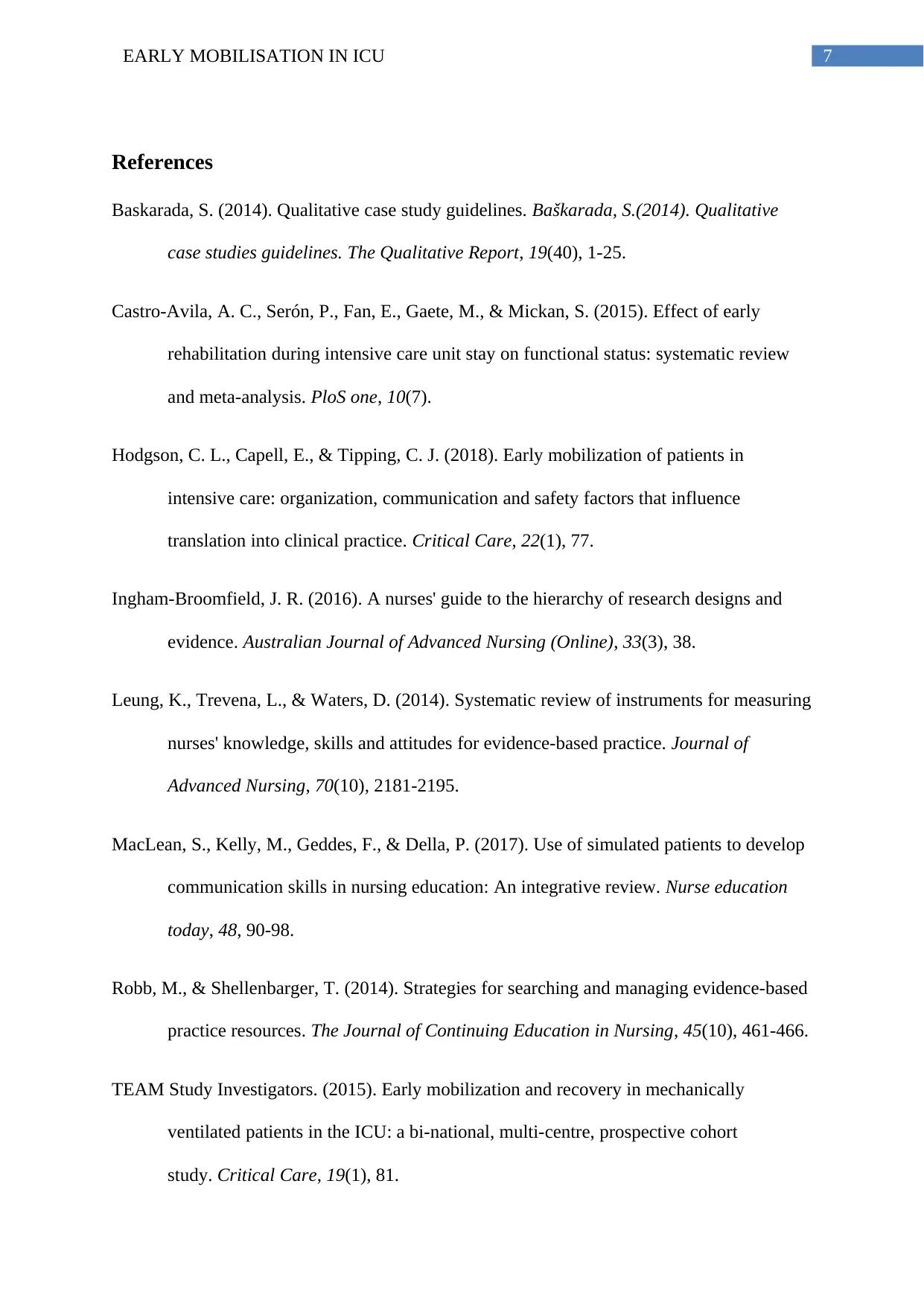
7EARLY MOBILISATION IN ICU
References
Baskarada, S. (2014). Qualitative case study guidelines. Baškarada, S.(2014). Qualitative
case studies guidelines. The Qualitative Report, 19(40), 1-25.
Castro-Avila, A. C., Serón, P., Fan, E., Gaete, M., & Mickan, S. (2015). Effect of early
rehabilitation during intensive care unit stay on functional status: systematic review
and meta-analysis. PloS one, 10(7).
Hodgson, C. L., Capell, E., & Tipping, C. J. (2018). Early mobilization of patients in
intensive care: organization, communication and safety factors that influence
translation into clinical practice. Critical Care, 22(1), 77.
Ingham-Broomfield, J. R. (2016). A nurses' guide to the hierarchy of research designs and
evidence. Australian Journal of Advanced Nursing (Online), 33(3), 38.
Leung, K., Trevena, L., & Waters, D. (2014). Systematic review of instruments for measuring
nurses' knowledge, skills and attitudes for evidence‐based practice. Journal of
Advanced Nursing, 70(10), 2181-2195.
MacLean, S., Kelly, M., Geddes, F., & Della, P. (2017). Use of simulated patients to develop
communication skills in nursing education: An integrative review. Nurse education
today, 48, 90-98.
Robb, M., & Shellenbarger, T. (2014). Strategies for searching and managing evidence-based
practice resources. The Journal of Continuing Education in Nursing, 45(10), 461-466.
TEAM Study Investigators. (2015). Early mobilization and recovery in mechanically
ventilated patients in the ICU: a bi-national, multi-centre, prospective cohort
study. Critical Care, 19(1), 81.
References
Baskarada, S. (2014). Qualitative case study guidelines. Baškarada, S.(2014). Qualitative
case studies guidelines. The Qualitative Report, 19(40), 1-25.
Castro-Avila, A. C., Serón, P., Fan, E., Gaete, M., & Mickan, S. (2015). Effect of early
rehabilitation during intensive care unit stay on functional status: systematic review
and meta-analysis. PloS one, 10(7).
Hodgson, C. L., Capell, E., & Tipping, C. J. (2018). Early mobilization of patients in
intensive care: organization, communication and safety factors that influence
translation into clinical practice. Critical Care, 22(1), 77.
Ingham-Broomfield, J. R. (2016). A nurses' guide to the hierarchy of research designs and
evidence. Australian Journal of Advanced Nursing (Online), 33(3), 38.
Leung, K., Trevena, L., & Waters, D. (2014). Systematic review of instruments for measuring
nurses' knowledge, skills and attitudes for evidence‐based practice. Journal of
Advanced Nursing, 70(10), 2181-2195.
MacLean, S., Kelly, M., Geddes, F., & Della, P. (2017). Use of simulated patients to develop
communication skills in nursing education: An integrative review. Nurse education
today, 48, 90-98.
Robb, M., & Shellenbarger, T. (2014). Strategies for searching and managing evidence-based
practice resources. The Journal of Continuing Education in Nursing, 45(10), 461-466.
TEAM Study Investigators. (2015). Early mobilization and recovery in mechanically
ventilated patients in the ICU: a bi-national, multi-centre, prospective cohort
study. Critical Care, 19(1), 81.
1 out of 8
Related Documents
Your All-in-One AI-Powered Toolkit for Academic Success.
+13062052269
info@desklib.com
Available 24*7 on WhatsApp / Email
![[object Object]](/_next/static/media/star-bottom.7253800d.svg)
Unlock your academic potential
Copyright © 2020–2025 A2Z Services. All Rights Reserved. Developed and managed by ZUCOL.





